fuel Alfa Romeo 159 2006 Owner handbook (in English)
[x] Cancel search | Manufacturer: ALFA ROMEO, Model Year: 2006, Model line: 159, Model: Alfa Romeo 159 2006Pages: 299, PDF Size: 4.64 MB
Page 83 of 299
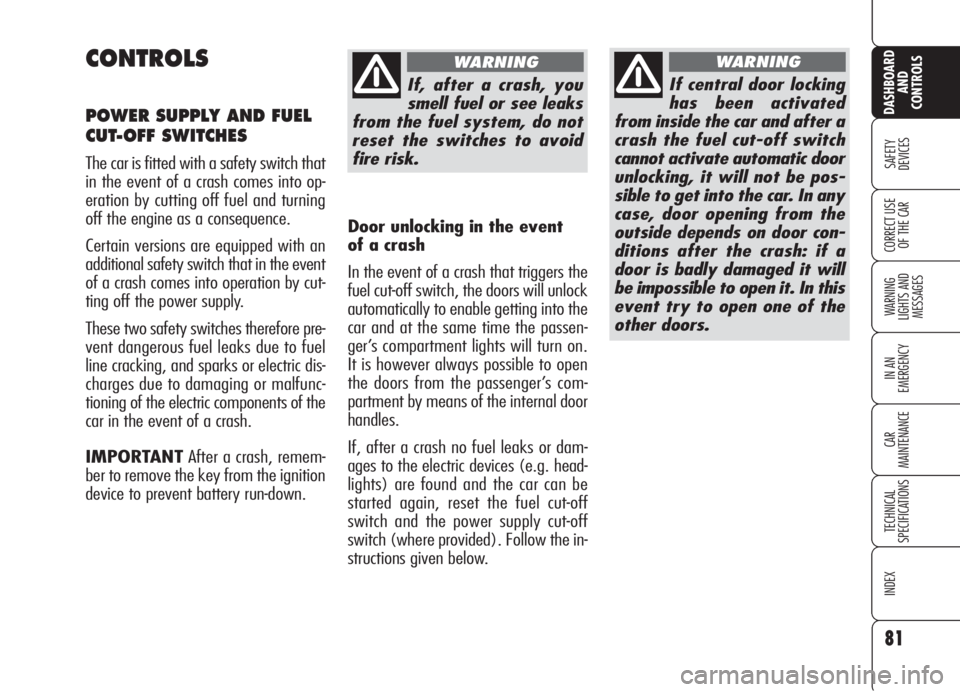
81
SAFETY
DEVICES
WARNING
LIGHTS AND
MESSAGES
IN AN
EMERGENCY
CAR
MAINTENANCE
TECHNICAL
SPECIFICATIONS
INDEX
CORRECT USE
OF THE CAR
DASHBOARD
AND
CONTROLS
CONTROLS
POWER SUPPLY AND FUEL
CUT-OFF SWITCHES
The car is fitted with a safety switch that
in the event of a crash comes into op-
eration by cutting off fuel and turning
off the engine as a consequence.
Certain versions are equipped with an
additional safety switch that in the event
of a crash comes into operation by cut-
ting off the power supply.
These two safety switches therefore pre-
vent dangerous fuel leaks due to fuel
line cracking, and sparks or electric dis-
charges due to damaging or malfunc-
tioning of the electric components of the
car in the event of a crash.
IMPORTANTAfter a crash, remem-
ber to remove the key from the ignition
device to prevent battery run-down.
If, after a crash, you
smell fuel or see leaks
from the fuel system, do not
reset the switches to avoid
fire risk.
WARNING
If central door locking
has been activated
from inside the car and after a
crash the fuel cut-off switch
cannot activate automatic door
unlocking, it will not be pos-
sible to get into the car. In any
case, door opening from the
outside depends on door con-
ditions after the crash: if a
door is badly damaged it will
be impossible to open it. In this
event try to open one of the
other doors.
WARNING
Door unlocking in the event
of a crash
In the event of a crash that triggers the
fuel cut-off switch, the doors will unlock
automatically to enable getting into the
car and at the same time the passen-
ger’s compartment lights will turn on.
It is however always possible to open
the doors from the passenger’s com-
partment by means of the internal door
handles.
If, after a crash no fuel leaks or dam-
ages to the electric devices (e.g. head-
lights) are found and the car can be
started again, reset the fuel cut-off
switch and the power supply cut-off
switch (where provided). Follow the in-
structions given below.
Page 84 of 299

82
SAFETY
DEVICES
WARNING
LIGHTS AND
MESSAGES
IN AN
EMERGENCY
CAR
MAINTENANCE
TECHNICAL
SPECIFICATIONS
INDEX
CORRECT USE
OF THE CAR
DASHBOARD
AND
CONTROLS
Resetting the power supply
cut-off switch
(where provided)The switch is located inside the fuse box
at battery positive terminal.
To reset the power supply cut-off switch,
proceed as follows:
❒press button A-fig. 61to reset the
fuel cut-off switch;
❒open the bonnet;
❒operate the retaining clips A-fig. 62
and remove the protection cover B;
❒press buttonC-fig. 63to reset the
power supply cut-off switch.
A0E0126mfig. 62
Before resetting the
power supply cut-off
switch carefully inspect the car
for fuel leaks or damages to
electric devices (e.g. head-
lights).
WARNING
A0E0071mfig. 63
Resetting the fuel cut-off
switch
Before resetting the fu-
el cut-off switch care-
fully inspect the car for fuel
leaks or damages to electric
devices (e.g. headlights).
WARNING
To reset the fuel cut-off switch, press but-
tonA-fig. 61.
A0E0221mfig. 61
Page 106 of 299
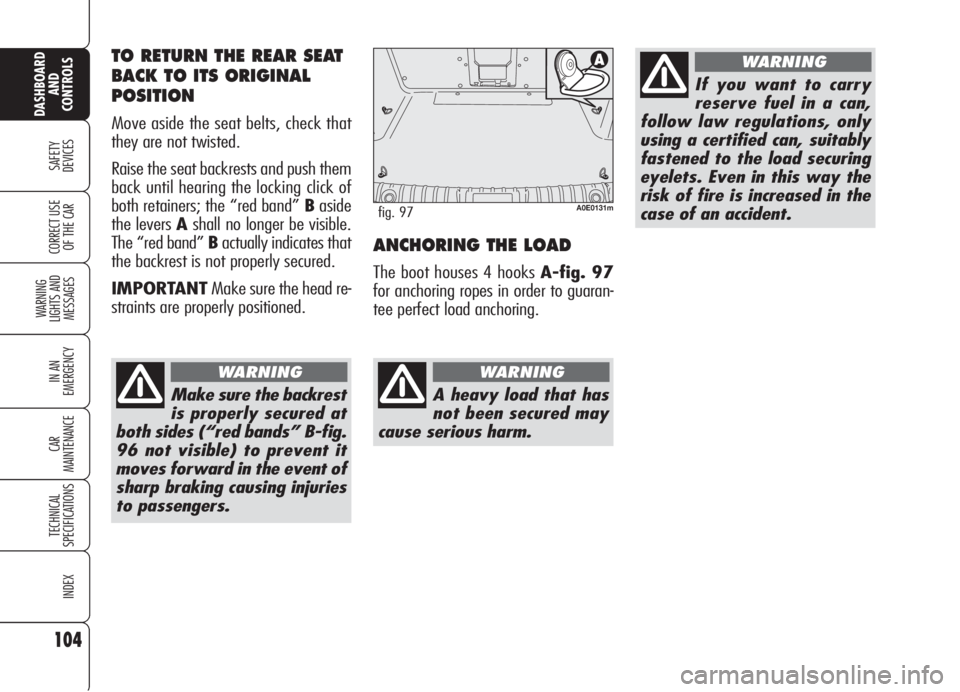
104
SAFETY
DEVICES
WARNING
LIGHTS AND
MESSAGES
IN AN
EMERGENCY
CAR
MAINTENANCE
TECHNICAL
SPECIFICATIONS
INDEX
CORRECT USE
OF THE CAR
DASHBOARD
AND
CONTROLS
ANCHORING THE LOAD
The boot houses 4 hooks A-fig. 97
for anchoring ropes in order to guaran-
tee perfect load anchoring.
A0E0131mfig. 97
A heavy load that has
not been secured may
cause serious harm.
WARNING
If you want to carry
reserve fuel in a can,
follow law regulations, only
using a certified can, suitably
fastened to the load securing
eyelets. Even in this way the
risk of fire is increased in the
case of an accident.
WARNINGTO RETURN THE REAR SEAT
BACK TO ITS ORIGINAL
POSITION
Move aside the seat belts, check that
they are not twisted.
Raise the seat backrests and push them
back until hearing the locking click of
both retainers; the “red band” Baside
the levers Ashall no longer be visible.
The “red band” Bactually indicates that
the backrest is not properly secured.
IMPORTANTMake sure the head re-
straints are properly positioned.
Make sure the backrest
is properly secured at
both sides (“red bands” B-fig.
96 not visible) to prevent it
moves forward in the event of
sharp braking causing injuries
to passengers.
WARNING
Page 109 of 299
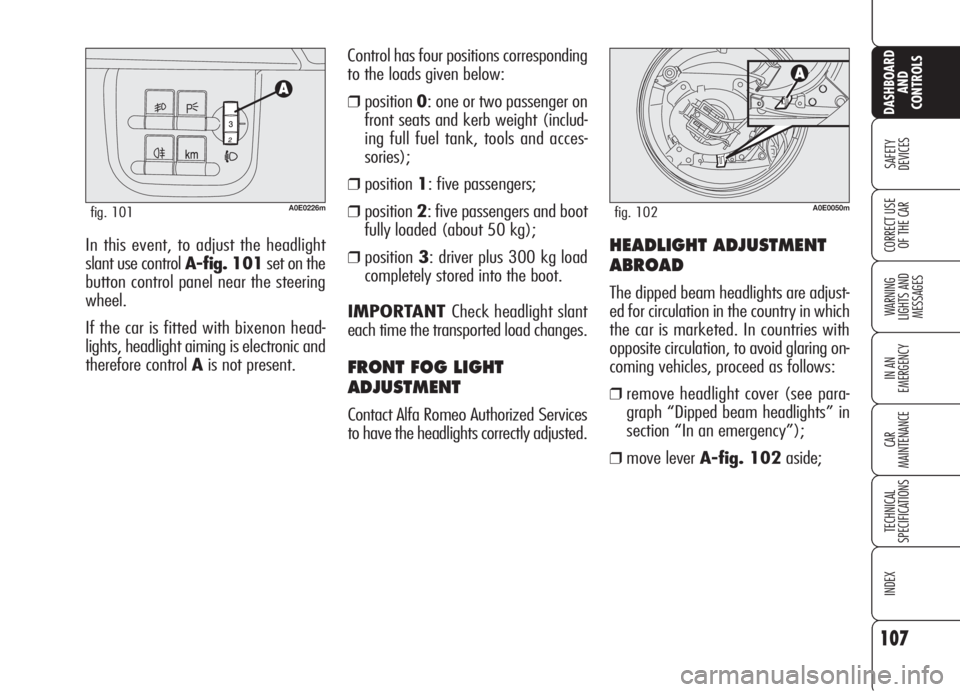
107
SAFETY
DEVICES
WARNING
LIGHTS AND
MESSAGES
IN AN
EMERGENCY
CAR
MAINTENANCE
TECHNICAL
SPECIFICATIONS
INDEX
CORRECT USE
OF THE CAR
DASHBOARD
AND
CONTROLS
In this event, to adjust the headlight
slant use control A-fig. 101set on the
button control panel near the steering
wheel.
If the car is fitted with bixenon head-
lights, headlight aiming is electronic and
therefore control Ais not present.Control has four positions corresponding
to the loads given below:
❒position0: one or two passenger on
front seats and kerb weight (includ-
ing full fuel tank, tools and acces-
sories);
❒position1: five passengers;
❒position2: five passengers and boot
fully loaded (about 50 kg);
❒position3: driver plus 300 kg load
completely stored into the boot.
IMPORTANT Check headlight slant
each time the transported load changes.
FRONT FOG LIGHT
ADJUSTMENT
Contact Alfa Romeo Authorized Services
to have the headlights correctly adjusted.
A0E0226mfig. 101
HEADLIGHT ADJUSTMENT
ABROAD
The dipped beam headlights are adjust-
ed for circulation in the country in which
the car is marketed. In countries with
opposite circulation, to avoid glaring on-
coming vehicles, proceed as follows:
❒remove headlight cover (see para-
graph “Dipped beam headlights” in
section “In an emergency”);
❒move lever A-fig. 102aside;
A0E0050mfig. 102
Page 127 of 299
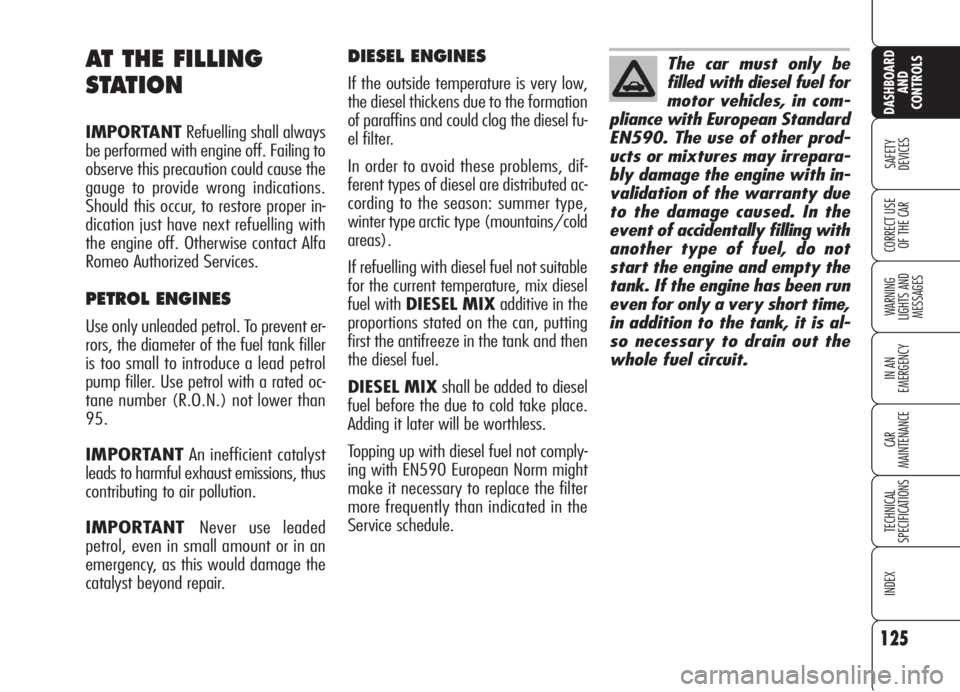
125
SAFETY
DEVICES
WARNING
LIGHTS AND
MESSAGES
IN AN
EMERGENCY
CAR
MAINTENANCE
TECHNICAL
SPECIFICATIONS
INDEX
CORRECT USE
OF THE CAR
DASHBOARD
AND
CONTROLS
DIESEL ENGINES
If the outside temperature is very low,
the diesel thickens due to the formation
of paraffins and could clog the diesel fu-
el filter.
In order to avoid these problems, dif-
ferent types of diesel are distributed ac-
cording to the season: summer type,
winter type arctic type (mountains/cold
areas).
If refuelling with diesel fuel not suitable
for the current temperature, mix diesel
fuel with DIESEL MIXadditive in the
proportions stated on the can, putting
first the antifreeze in the tank and then
the diesel fuel.
DIESEL MIXshall be added to diesel
fuel before the due to cold take place.
Adding it later will be worthless.
Topping up with diesel fuel not comply-
ing with EN590 European Norm might
make it necessary to replace the filter
more frequently than indicated in the
Service schedule.
AT THE FILLING
STATION
IMPORTANTRefuelling shall always
be performed with engine off. Failing to
observe this precaution could cause the
gauge to provide wrong indications.
Should this occur, to restore proper in-
dication just have next refuelling with
the engine off. Otherwise contact Alfa
Romeo Authorized Services.
PETROL ENGINES
Use only unleaded petrol. To prevent er-
rors, the diameter of the fuel tank filler
is too small to introduce a lead petrol
pump filler. Use petrol with a rated oc-
tane number (R.O.N.) not lower than
95.
IMPORTANTAn inefficient catalyst
leads to harmful exhaust emissions, thus
contributing to air pollution.
IMPORTANT Never use leaded
petrol, even in small amount or in an
emergency, as this would damage the
catalyst beyond repair.
The car must only be
filled with diesel fuel for
motor vehicles, in com-
pliance with European Standard
EN590. The use of other prod-
ucts or mixtures may irrepara-
bly damage the engine with in-
validation of the warranty due
to the damage caused. In the
event of accidentally filling with
another type of fuel, do not
start the engine and empty the
tank. If the engine has been run
even for only a very short time,
in addition to the tank, it is al-
so necessary to drain out the
whole fuel circuit.
Page 128 of 299

126
SAFETY
DEVICES
WARNING
LIGHTS AND
MESSAGES
IN AN
EMERGENCY
CAR
MAINTENANCE
TECHNICAL
SPECIFICATIONS
INDEX
CORRECT USE
OF THE CAR
DASHBOARD
AND
CONTROLS
EMERGENCY OPENING OF
THE FUEL FILLER CAP
In case of failure, the fuel filler cap can
be opened by pulling string set on the
right side of the boot fig. 110.
A0E0130mfig. 110
FUEL FILLER CAP
The fuel filler cap is unlocked when cen-
tral door locking is off and it is auto-
matically locked when activating the
central door locking. To open the fuel
filler cap, operate as shown by the ar-
row infig. 108.
The fuel filler cap is A-fig. 109 fitted
with an antiloss device Bwhich fastens
it to the flap Cso it cannot be mislaid.
A0E0159mfig. 108A0E0160mfig. 109
Do not put naked
flames or lighted ciga-
rettes near the fuel filler hole
as there is danger of fire. Do
not bend too close to the hole
either so as not to breathe in
harmful vapours.
WARNING
When refuelling, position the cap on the
device inside the flap as shown in the
figure.
IMPORTANTThe sealing of the tank
may cause light pressurising in the tank.
A little breathing off, while slackening
the cap, is absolutely normal.
Page 129 of 299
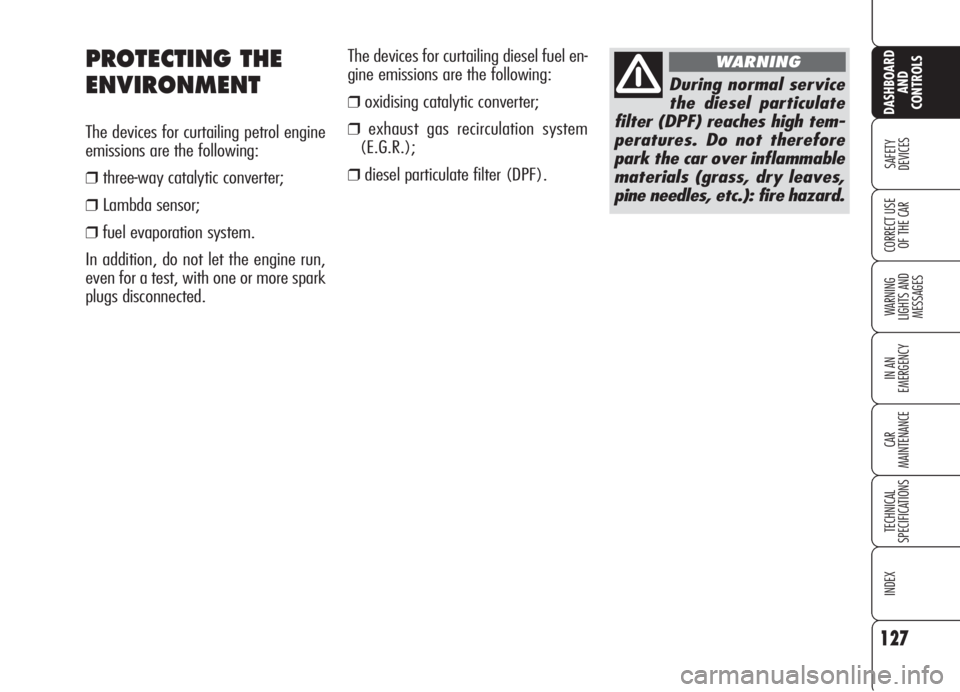
127
SAFETY
DEVICES
WARNING
LIGHTS AND
MESSAGES
IN AN
EMERGENCY
CAR
MAINTENANCE
TECHNICAL
SPECIFICATIONS
INDEX
CORRECT USE
OF THE CAR
DASHBOARD
AND
CONTROLS
The devices for curtailing diesel fuel en-
gine emissions are the following:
❒oxidising catalytic converter;
❒exhaust gas recirculation system
(E.G.R.);
❒ diesel particulate filter (DPF).
PROTECTING THE
ENVIRONMENT
The devices for curtailing petrol engine
emissions are the following:
❒ three-way catalytic converter;
❒ Lambda sensor;
❒ fuel evaporation system.
In addition, do not let the engine run,
even for a test, with one or more spark
plugs disconnected.
During normal service
the diesel particulate
filter (DPF) reaches high tem-
peratures. Do not therefore
park the car over inflammable
materials (grass, dry leaves,
pine needles, etc.): fire hazard.
WARNING
Page 156 of 299

154
SAFETY
DEVICES
WARNING
LIGHTS AND
MESSAGES
IN AN
EMERGENCY
CAR
MAINTENANCE
TECHNICAL
SPECIFICATIONS
INDEX
DASHBOARD
AND
CONTROLS
CORRECT USE
OF THE CAR
IMPORTANTAfter a taxing drive, you
should allow the engine to “catch its
breath” before turning it off by letting it
idle to allow the temperature in the en-
gine compartment to fall.
IMPORTANTTurning the car off will
deactivate the electronic safety systems
and turn off the external lights.IMPORTANTIn the event of engine
locking while the car is running, due to
safety reasons it will not be possible to
take the electronic key out of the igni-
tion device. To remove it, turn the in-
strument panel on and off by pressing
buttonSTART/STOPwith brake ped-
al (and clutch pedal) released and car
stopped.
REMOVING THE ELECTRONIC
KEY FROM THE IGNITION
DEVICE IN AN EMERGENCY
In the event of a failure at engine switch-
ing off system or at electronic key un-
locking system proceed as follows:
❒press the unlocking button to remove
the metal insert (see paragraph
“Electronic key” in section “Dash-
board and controls”);
STOPPING THE ENGINE
With car stopped press button START/
STOP. When the engine is off it will be
possible to remove the electronic key
from the ignition device.
A quick burst on the ac-
celerator before turning
off the engine serves
absolutely no practical purpose,
it wastes fuel and is damaging
especially to turbocharged en-
gines.❒fit the metal insert B-fig. 1of the
electronic key into the slot A;
❒remove the electronic key from the
ignition device.
IMPORTANTOnly fit the metal insert
Bof the electronic key into slot A-fig.1.
IMPORTANTStop the car before
emergency removal of the key, since re-
moving the key with the engine running
will turn both the engine and the in-
strument panel off and the steering lock
will not be engaged.
A0E0043mfig. 1In an emergency, and
for safety reasons the
engine can be turned off when
the car is running by pressing
repeatedly (3 times within
2 seconds) or by keeping
pressed button START/STOP
for a few seconds. In this case
the steering lock cannot be en-
gaged.
WARNING
Page 160 of 299

158
SAFETY
DEVICES
WARNING
LIGHTS AND
MESSAGES
IN AN
EMERGENCY
CAR
MAINTENANCE
TECHNICAL
SPECIFICATIONS
INDEX
DASHBOARD
AND
CONTROLS
CORRECT USE
OF THE CAR
Gear selection
As soon as the conditions of the traffic
and road allow, use a higher gear. Us-
ing a low gear to obtain brilliant perfor-
mance increases consumption. In the
same way improper use of a high gear
increases consumption, emissions an en-
gine wear.
Top speed
Fuel consumption considerably increas-
es with speed. Avoid superfluous brak-
ing and accelerating, which cost in terms
of both fuel and emissions.
Acceleration
Accelerating violently increasing the revs
will greatly affect consumption and emis-
sions: acceleration should be gradual and
should not exceed the maximum torque.CONDITIONS OF USE
Cold starting
Short journeys and frequent cold starts
do not allow the engine to reach opti-
mum operating temperature. This results
in a significant increase in consumption
levels (from +15 to +30% on the urban
cycle) and emission of harmful sub-
stances.
Traffic and road conditions
Rather high consumption levels are tied
to situations with heavy traffic, for ex-
ample in queues with frequent use of
the lower gears or in cities with many
traffic lights. Also winding mountain
roads and rough road surfaces adverse-
ly affect consumption.
Traffic hold-ups
During prolonged hold-ups (e.g.: level
crossings) the engine should be
switched off.
DRIVING STYLE
Starting
Do not warm the engine with the car
at a standstill or at idle or high speed:
under these conditions the engine
warms up much more slowly, increasing
electrical consumption and emissions. It
is therefore advisable to move off im-
mediately, slowly, avoiding high speeds.
This way the engine will warm faster.
Unnecessary actions
Avoid accelerating when waiting at traf-
fic lights or before switching off the en-
gine. This and also double declutching
is absolutely pointless on modern cars
and also increase consumption and pol-
lution.
Page 167 of 299
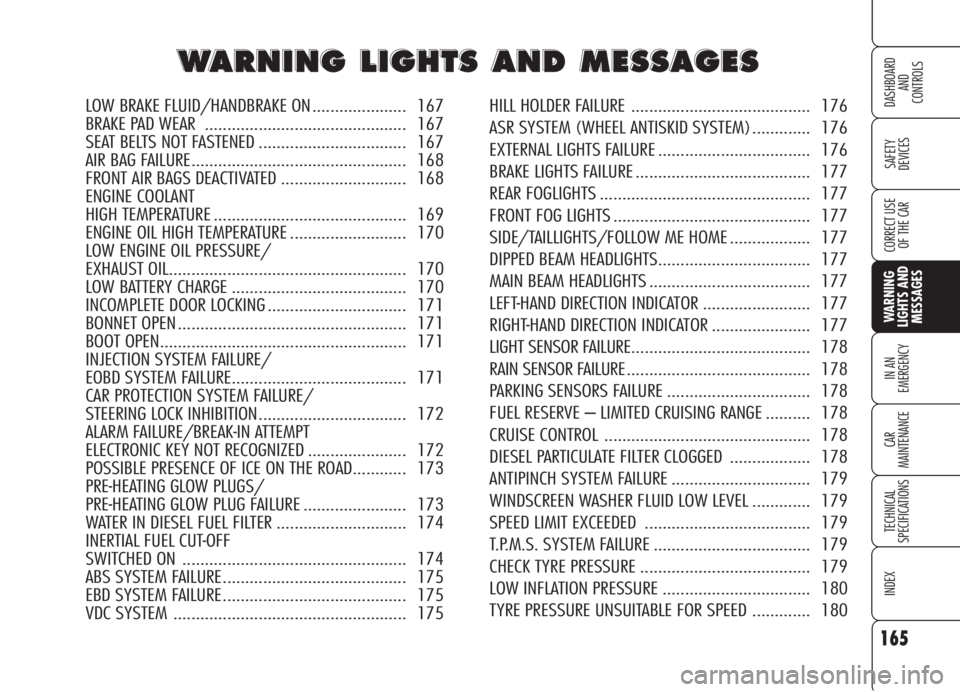
165
SAFETY
DEVICES
IN AN
EMERGENCY
CAR
MAINTENANCE
TECHNICAL
SPECIFICATIONS
INDEX
CORRECT USE
OF THE CAR
DASHBOARD
AND
CONTROLS
WARNING
LIGHTS AND
MESSAGES
W W
A A
R R
N N
I I
N N
G G
L L
I I
G G
H H
T T
S S
A A
N N
D D
M M
E E
S S
S S
A A
G G
E E
S S
LOW BRAKE FLUID/HANDBRAKE ON ..................... 167
BRAKE PAD WEAR ............................................. 167
SEAT BELTS NOT FASTENED ................................. 167
AIR BAG FAILURE................................................ 168
FRONT AIR BAGS DEACTIVATED ............................ 168
ENGINE COOLANT
HIGH TEMPERATURE ........................................... 169
ENGINE OIL HIGH TEMPERATURE .......................... 170
LOW ENGINE OIL PRESSURE/
EXHAUST OIL..................................................... 170
LOW BATTERY CHARGE ....................................... 170
INCOMPLETE DOOR LOCKING ............................... 171
BONNET OPEN ................................................... 171
BOOT OPEN....................................................... 171
INJECTION SYSTEM FAILURE/
EOBD SYSTEM FAILURE....................................... 171
CAR PROTECTION SYSTEM FAILURE/
STEERING LOCK INHIBITION................................. 172
ALARM FAILURE/BREAK-IN ATTEMPT
ELECTRONIC KEY NOT RECOGNIZED ...................... 172
POSSIBLE PRESENCE OF ICE ON THE ROAD............ 173
PRE-HEATING GLOW PLUGS/
PRE-HEATING GLOW PLUG FAILURE ....................... 173
WATER IN DIESEL FUEL FILTER ............................. 174
INERTIAL FUEL CUT-OFF
SWITCHED ON .................................................. 174
ABS SYSTEM FAILURE......................................... 175
EBD SYSTEM FAILURE......................................... 175
VDC SYSTEM .................................................... 175HILL HOLDER FAILURE ........................................ 176
ASR SYSTEM (WHEEL ANTISKID SYSTEM) ............. 176
EXTERNAL LIGHTS FAILURE .................................. 176
BRAKE LIGHTS FAILURE ....................................... 177
REAR FOGLIGHTS ............................................... 177
FRONT FOG LIGHTS ............................................ 177
SIDE/TAILLIGHTS/FOLLOW ME HOME .................. 177
DIPPED BEAM HEADLIGHTS.................................. 177
MAIN BEAM HEADLIGHTS .................................... 177
LEFT-HAND DIRECTION INDICATOR ........................ 177
RIGHT-HAND DIRECTION INDICATOR ...................... 177
LIGHT SENSOR FAILURE........................................ 178
RAIN SENSOR FAILURE......................................... 178
PARKING SENSORS FAILURE ................................ 178
FUEL RESERVE – LIMITED CRUISING RANGE .......... 178
CRUISE CONTROL .............................................. 178
DIESEL PARTICULATE FILTER CLOGGED .................. 178
ANTIPINCH SYSTEM FAILURE ............................... 179
WINDSCREEN WASHER FLUID LOW LEVEL ............. 179
SPEED LIMIT EXCEEDED ..................................... 179
T.P.M.S. SYSTEM FAILURE ................................... 179
CHECK TYRE PRESSURE ...................................... 179
LOW INFLATION PRESSURE ................................. 180
TYRE PRESSURE UNSUITABLE FOR SPEED ............. 180